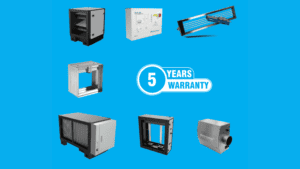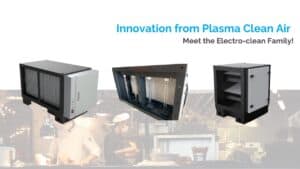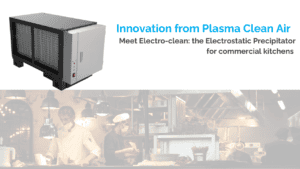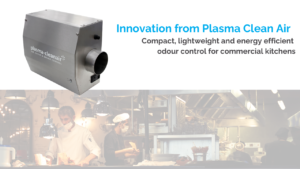Efficient ventilation in commercial kitchens is crucial for maintaining a safe, comfortable, and compliant environment. Whether you’re a building services consultant, M&E contractor, or a kitchen operator, understanding the right solutions for controlling grease, odours, and smoke is essential for long-term success. In this blog, we’ll walk you through the journey from canopy to extract, focusing on key technologies for maintaining clean, compliant, and efficient ventilation systems.
Canopy Grease Filters: Your First Line of Defence
At the heart of every commercial kitchen ventilation system is the canopy. The canopy’s primary role is to capture heat, steam, and airborne contaminants, but its effectiveness heavily depends on the quality of the grease filters installed. Canopy grease filters are your first line of defence against grease build-up within the ductwork. These filters capture grease particles before they enter the exhaust system, helping reduce the risk of fires and extending the lifespan of the entire ventilation system.
Not all canopy grease filters are equal though. At best, most baffle filters are 20-40% efficient at capturing grease whilst high efficiency canopy grease filters have a high pressure drop requiring more fan power to drive air through them.
By combining a baffle filter with a 100% Wool Filter System provides a sustainable, preventative solution to grease build-up in commercial kitchen extract systems. Grease Bloc Eco are easy-to-install, low pressure drop wool filters which capture up to 98% of grease particles. This dramatically reduces fire risk by preventing grease from reaching the ductwork, fan, or rooftop and reduces the need for TR19 canopy and duct cleans. Their biodegradable nature and low-pressure drop makes disposal environmentally friendly and a vital component for any commercial kitchen aiming to hit Net Zero.
Canopy UV: Tackling Grease and Odour at the Source
A step further in grease and odour control is incorporating ultraviolet (UV ozone) technology within the canopy. Canopy UV systems are designed to break down grease molecules using UV-C light, turning grease into smaller, more manageable compounds. This not only helps in reducing grease accumulation but also minimises odours by neutralising the organic particles responsible for unpleasant smells.
In addition, UV systems contribute to cleaner ductwork, reducing the frequency of maintenance and TR19 cleaning while ensuring compliance with health and safety regulations. For busy kitchens, especially in sectors like hospitality or healthcare, this is a valuable solution for ongoing hygiene management.
Canopy UV is also an ideal solution where there is limited plant space.
Electrostatic Precipitators (ESP): Advanced Smoke and Grease Control
Once air has passed through the canopy filters, electrostatic precipitators (ESP) take smoke and fine grease particle control to the next level. ESP technology works by charging particles within the exhaust stream and trapping them on collector plates, effectively capturing grease, smoke, and fine particulate matter. This solution is ideal for kitchens with high grease and smoke levels, such as fast food and casual dining restaurants serving dishes such as Piri Piri chicken, burgers, steaks cooked on a char-grille.
With ESP systems, kitchens can significantly reduce emissions, ensuring that exhaust air is cleaner and more environmentally friendly. ESP units are highly efficient, ensuring compliance with environmental standards and minimising complaints from nearby residents or businesses about smoke or odour emissions.
Xtract UV Ozone Injection: Powerful Odour Control for Commercial Kitchens
The Xtract ozone injection system is a small footprint solution which is ideal for eliminating odours in kitchen ventilation applications with limited plant space. Unlike activated carbon, there is no additional static pressure so it is suitable for retrofit and new kitchen schemes alike. The Xtract 2100 and 4200 models inject controlled amounts of ozone into the ductwork to neutralise odour-causing molecules, effectively reducing odour emissions before the air is released outside.
Xtract UV ozone can be used on its own or in combination with activated carbon in applications where it is not possible to achieve 2s contact time between UV ozone and the cooking smells. This system is especially beneficial for kitchens in urban areas or near residential spaces, where odour control is critical. With Xtract, operators can ensure that their kitchen remains compliant with environmental regulations, while minimising complaints from neighbours and maintaining a cleaner exhaust system.
In-Duct UV: Advanced Grease and Odour Control
For commercial kitchens requiring high-performance grease and odour control, in-duct UV systems offer a powerful solution. In-duct UV can be used alone or combined with ESPs to provide a comprehensive grease, smoke and odour control solution.
The Techniclean duct-mounted UV system uses UV ozone to break down grease and odour molecules directly within the kitchen’s ductwork. As exhaust air passes through the UV system, grease particles are broken down into smaller, more manageable compounds, reducing grease build-up in the ducts. This process not only minimises the risk of fires but also significantly reduces odours by neutralising the organic compounds responsible for unpleasant smells. In-duct UV systems are ideal for kitchens in busy urban environments or areas with strict air quality regulations, offering an effective, low-maintenance solution to improve ventilation efficiency and ensure compliance with environmental standards.
Comprehensive Odour Control
Odour control is one of the most challenging aspects of commercial kitchen ventilation. In addition to in-canopy and in-duct UV and ESP systems, there are solutions like carbon filtration and UV ozone injection. Carbon filters capture odorous compounds, while UV ozone injection systems chemically break down these compounds, ensuring that the air released from the kitchen is odour-free. For kitchens located in densely populated areas or near residential buildings, effective odour control can make a significant difference in preventing nuisance complaints and maintaining positive relationships with the community.
Conclusion
From canopy grease filters to UV technology, ESPs, and advanced odour control, a well-designed commercial kitchen ventilation system ensures compliance with safety regulations, reduces maintenance costs, and enhances the overall air quality of the building. For owners, operators, and M&E contractors, these technologies represent an investment in safety, efficiency, and long-term sustainability.
Get in touch today to ensure your kitchen ventilation system is equipped with the latest in grease, odour, and smoke control solutions for optimal performance and peace of mind.








